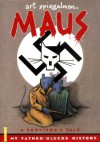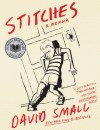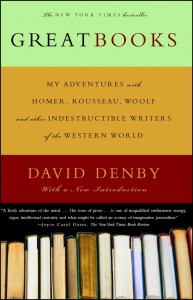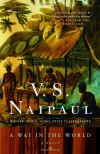Dog-Eared Pages
My favorite books, ideas, and a few plugs for whatever book I'm currently working on...
A Review of Eleanor & Park: A Book That Looks Like Art

If Superheroes Ruled the World: Millar's Superman: Red Son

I’ve always been a fan of Superman, the myth: that is, the mythical idea behind Superman—the alien who is the last of his kind, who grows up in the similarly ‘mythical’ setting of small-town America, and becomes a champion of the common man. Unfortunately, once past this point there isn’t a lot you can really do with Superman: he’s potentially quite dull, since he lacks the psychological depth of a Batman (no dark secrets whispering beneath his cape). Yet Mark Millar’s Superman: Red Son reminded me that a myth can do anything, especially a myth born from the frames of a comic book. Comic books are unique in that you can have 400 issues of a comic and then go right back to the beginning. Continuity is not really possible when a reader comes in at issue #45, only to leave around #98, and perhaps return at #225. That’s why the superheroes that last are the ones with the best origins; you can continually go back to the well and imagine how the myth might blossom in new and exciting ways.
As Joseph Campbell expressed in The Hero With a Thousand Faces, the hero’s journey is quite similar throughout time and culture—only the face/mask changes. As readers, we love the story about how the mask is put on, or why the hero decides to embark on such a dangerous and epic quest. Much of what happens later is tangential, or at least not part of the character’s true immortality. This is certainly the case with Superman, whose early comics introduced many iconic characters—most notably, Lex Luthor—but didn’t contribute to the stories we tell and re-tell today. After all, who remembers Superman’s early tussle with a nefarious villain named “The Light”? Though I’m sure you can imagine who came out on top...
Superman: Red Son starts at the beginning—or in a way, ends with the beginning (but you’ll have to read the entire book to understand that statement). However, a simple idea becomes a profound variation on the Superman legend: what if he had landed in the Soviet Union (which is a much larger country, after all) and grown up in a collective farm in the Ukraine? Again, nothing substantial changes here: in both stories (old and new), he becomes emblematic of the heartland, where the ‘true’ nation exists. And in both stories, he rises up to defend the common citizen and become a flag-waving emblem of democracy—or in this case, Communism. Here the similarities end, though Millar is clever enough to sprinkle in all the familiar icons in surprising ways, making the comic a rich, complex narrative—and indeed, a novel. Not all comics collected into a book format seem deserving of the title ‘graphic novel,’ but this one does; it’s a gripping story which is part science fiction and part pulp superhero. Yet the overwhelming sense at the end is having read a very good story—and one you’ve never heard before.
Without giving away too much of the plot, Superman becomes Stalin’s right hand man, and once the ‘great’ man dies, Superman is urged to take over. At the same time, Luthor is plotting to beat Superman at his own game, making one villainous monstrosity after another—all sponsored by the US government—in order to defeat him and prove the superior intellect. Once Superman accepts leadership of the Soviet Union, his reign becomes a true utopia—which in the science-fiction world always means dystopia (since “utopia” is Latin for “nowhere”). Crime and poverty are eradicated, and all dissidents are carefully ‘reprogrammed’ to fall in line with Superman’s enlightened views for peace and prosperity. True, it all works, but some people would rather die than be saved by a superhuman tyrant: enter Batman, a notorious terrorist who plots Superman’s downfall and soon cultivates a network of dissidents. Superman’s only true ally is Wonder Woman, the superhuman ambassador of Themyscira, who secretly pines for Supe’s affections.
The final showdowns with ‘evil’ (meaning Luthor and the USA) pits Superman against Batman, Green Lantern (or a whole squadron of Green Lanterns, whose power comes from a crashed alien spaceship in ‘Area 51’) and Braniac, who has his own plans for humanity’s future. Within the usual comic book heroics, Millar takes a page from Moore’s Watchmen, blurring historical fact with fiction to ask the question, who should be allowed to save—or rule—the world? Who acts in humanity’s best interests? Could even Superman show us the way forward? In a powerful scene, Lois Luthor is discussing her husband (now president’s) plans for ruling the world and destroying Superman. As she notes, “Superman might be a nut with a messiah complex, but don’t you think we’re in danger of just replacing one demagogue with another?” The response, from one of Luther’s functionaries, is simply, “Very possibly, darling, but at least Lex Luthor is a demagogue who speaks English” (113). It’s a chilling point in a narrative where both good and bad intentions seem to lead to the same result—only the language changes.
The rest I’ll lead for you to read and explore for yourself. While this is a Superman cut from the cloth of Miller’s Dark Knight or Moore’s Watchmen, it’s still a distinct and moving work—dark in its prediction of human morals, but optimistic in the possibility of the power of simple men and women (those without great powers) to make the right decisions. I consider this one of the most satisfying graphic novels dealing with a mythical hero I’ve ever read, and I’ll go back to this time and time again. Superman will always be reinvented, and many new Superman comics have followed in his wake; but after Superman: Red Son, none of them will be able to resist a glance over their shoulder to ask, “what can I possibly do after that?”
Reading Graphic Novels in College: My Graphic Novels Blog
Check out the blog for my Winter Intercession class on Graphic novels: the students this semester are reading 4 central books--Superman: Red Son, Maus I, Stitches, and Fun Home--and then writing a longer paper/presentation on other works. The blogsite currently features dozens of mini-reviews of graphic novels/comics as well as their first-hand responses to the works in class. It's a great way to find a new favorite book, or to see what new readers feel about your old favorite. Feel free to respond to the books and/or the students in class. We always have room for another "student"!
A Great TCOTLD Review by Patricia Reding: Keystone Cops, Who's on First, The Three Stooges—and—What's that You Say!?
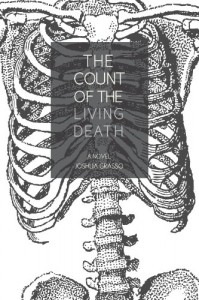
What do all the things noted in my title have to do with this work? Well, of late I have read a couple of fantasy-comedies. This seems to be a new sub-genre of fantasy—at least it is not one of which I previously had been aware. In any case, kudos to those—like Joshua Grasso—who have taken to this concept, run with it and successfully created tales worthy of attention.
As The Count of the Living Death opens, Grasso introduces readers to Count Hildigrim Blackbeard. (What a great name that is! Hildigrim!) Blackbeard is an eccentric wizard, the “legendary Conjurer-Magician and Sorcerer of the Sixth Circle (whatever that means).” Feared by some, pursued by others, Blackbeard has been called to attend Count Leopold of Cinquefoil. It seems the Count’s now-deceased father is/was responsible for a comedic chain-of-events that is about to unravel. So fearful had the late Count been of the possible death of his son, he had arranged for Blackbeard to capture Leopold’s “Death” and to leave it in a chest under lock and key. (Well, three locks, to be more precise.) But, the box called out for Leopold. Indeed, the very fact that it existed “planted a seed in [Leopold’s heart], which grew year by year, watered by his dreams and the occasional nightmare.” Eventually Leopold, though repeatedly warned not go near the chest or to unlock it, was overcome with curiosity. He simply had to know what the chest held. . . . And so, the fun begins.
The Count of the Living Death is almost slapstick in its comedic ways. The story revolves largely around the Count himself who is short on patience and forethought, (not exactly dim-witted, but not the brightest of bulbs) long on his desire for the delightful Lady Mary Bianca Domenica de Grassini Algarotti. As to Mary? Well, Mary has been taught to stand like a goddess and so, we read that “[h]aving never seen one in person, she did her best impression: she stood like her mother.” (Funny.) Mary is a bit flighty, dreaming of a future with Leopold and their future children, yet in many ways she is the key ingredient to the eventual solution to Leopold’s problem.
Into the mix of characters, add Ivan (The Terrible) a half-brother (?) charged as “an assassin, a spy, a cutpurse, a highwayman, and most unforgivably, an actor.” We first meet Ivan when he is in prison. He a man whom Leopold had never before met but who over time, also falls for the delightful Mary. It is here that I find the story miss just a beat. Specifically, Leopold and Ivan—quite at odds with one another—are suddenly the closest of brothers. Yet, for me, there was not a sufficient rationale for this change in their relationship. Likewise, Mary first despises Ivan—and for good reason—yet she is able to look beyond the vilest of acts with little further thought.
Moving on, we meet Lucas, a servant to the man to whom Mary is actually promised (and who also falls for the delightful Mary!) and Philip, a terror of a child in charge of the local prison (who thinks that “[s]ometimes, toys had to be broken when they wouldn’t follow the rules”). Finally, there is Death himself, who wreaks havoc. Add in a deserted island, a dragon, a staged hanging, a prison break. . . . Well, together these make for a fun-filled tale. Along the way, readers are asked: without death, a “vital ingredient to life,” can anything give us peace, rest or fulfillment?
In general, my reading preferences are for a bit more complex characters, sophisticated relationships and a world that engages all my senses. Even so, I am fully able to appreciate the many ways to tell a great tale—and Grasso has found lit upon one of them! He has done so with some clever insight and, of course, humor.
As to insight, I note Blackbeard’s comment: “If we could see all the wisdom of the universe, it would blind us.” (This line reminds me of a theory of mine that if a person could take on all the pain he will feel in his lifetime in one moment—just to get it over with—it would kill him. Thus, we should be grateful that we do not know what the future holds. . . .)
As to humor, consider Mary’s thoughts when she faces Leopold’s (?) apparent lack of interest. Concerned for her future, we read: “Suddenly ‘forever’ seemed a forbidding prospect.” Again, when Mary’s father tells Mary about his forcing her to marry a man she does not love, an act he takes by virtue of his “right of seniority,” we read his comments to Mary: “One day you will be able to buy whatever you like: love, happiness, my head on a plate.”
Yes, I believe Grasso has delivered, in The Count of the Living Death, a fun-filled, slapstick fantasy tale that readers are sure to enjoy! Well done!
Find The Count of the Living Death on Amazon here. Note: there is a sale starting December 16—just in time for the holidays! Don't miss it!
Spend some more time getting to know Joshua Grasso with my interview of him here on BookLikes or on my website here. Also, find him on BookLikes here and on GoodReads here. Joshua's Facebook page is here. Finally, Joshua has a terrific website here.
"Gold doesn't always mean gold"...unless it's this book!

As a father I’m always on the hunt for new YA books—whether fantasy, science fiction, or something of the ‘real’ world—that will entrance my boys. I’m looking for something that I would have liked to read at their age, to inspire them to their own ideas and adventures. However, I have an ulterior motive as well: as a frustrated novelist, I’m always on the lookout for that one book that will make me go, “here it is—the book I could never possibly write so I can finally stop writing!” Both motives seemed to converge when I ran across this volume, with a beautiful cover and striking, Old World fairy-tale illustrations (and maps!) inside. Though ostensibly for my oldest son, I checked out the book and tucked into it that very evening, reading it every chance I got, despite grading that needed to be done and other important adult concerns. In large part, the book amply repaid my expectations; and while I might not retire the pen just yet, Almhjell’s second novel may be the final nail in my literary coffin.
Without spoiling too much, I’ll reveal the general frame of the story: Lin Rosenquist, a plucky young heroine, finds a strange key concealed in a letter that ends up unlocking a hidden door in a cellar filled with taxidermist horrors. The door leads to a frozen world where she is reunited with her pet vole, Rufus, who died five weeks ago. After a frightful adventure, he brings her to the main town, Sylveros, an enchanted realm populated by “Petlings,” or pets that were once loved by human children. Here they watch over their children back home and prepare for the next coming of the Wanderer, a blazing star that lights up the sky and completes a crucial magical cycle. However, the momentary unbalance brings out the potential for darkness—and to combat it, a Twistrose is summoned from among the Petling’s children. It turns out Lin is this very Twistrose, and she is summoned in most dire need: for the last of the Winterfrysts is missing, a powerful race of ice creatures who alone can create the Wandersnow, the magical ‘glue’ that binds the realm. With Rufus as her guide, she sets off to follow a trail of clues to discover the fate of Isvan, the last Winterfryst, while certain residents—notably the shifty cat, Figenskar—take an eager interest in her arrival.
Tone Almhjell magnificently creates a believable world that seems to have existed long before anyone picked up the book—or indeed, she even wrote a word of the story. We are dropped into Sylveros quite “in the middle,” and have to pick up the pieces along with Lin, as Almhjell avoids any florid exposition. Every page suggests a deep history, some of it resembling the worlds of Narnia, Middle Earth, and even Harry Potter, though the larger part seemingly carved out of the rock and ice of Norwegian folklore. Figuring out the twists and turns of Sylveros, and the forbidding lands beyond, is the chief appeal of the story. The map in the front of the book helps us navigate this enchanted realm, taking us from the mouthwatering smells of Waffleheart to the chilling secrets of the Observatory. The characters are well drawn, and the plot is hidden in several layers of mystery, chief among these the haunting “Margrave’s Song” which Lin discovers early in the book. Almhjell wraps up the entire plot in this song, though it takes all of 350 pages to really decipher it. The twists and turns of the book are truly enjoyable, clever, and never hackneyed. I was always left guessing how Lin would solve the mystery and save Sylveros, even a mere page or two before she did so! This is truly a testament to Almhjell’s sense of pacing and structure; she tells a fantastic story and knows just when to pull back.
However, it is a first novel, and it has some small ‘flaws,’ if you will (though they are very minor). Some issues of the plot and the world of Sylveros are never definitively explained, and one or two major issues only come to light in the very closing pages; indeed, one of the main characters even exclaims, “Why the rats have you not told us this before?” (329). Obviously this was intentional, but the ending seems a bit rushed and full of expository information that might have bubbled up sooner. After a very leisurely and well-paced first 250 or so pages, I truly felt the scramble to 354 was a bit of a dash. The parting with Sylveros is also quite abrupt, and seemingly at odds with the rest of the book. I wanted her to linger more in this world, to let Lin understand the legacy of her mission, and perhaps, forge a connection to future books (if she plans to write them). There are also bits of repetitive detail that don’t wear as well for me, such as Lin’s obsession with rewarding herself points whenever she accomplishes something, or constantly telling herself to think harder, look deeper when she finds herself stuck. This, however, is probably subjective as these are integral to Lin’s character.
This aside, Almhjell’s writing makes you forget these misgivings—you quickly lose yourself in a story that sounds as timeless as a fairytale and as invigorating as a troll hunt. She has an uncanny ability to conjure up a child’s perspective and understanding of the world, yet without abandoning the very adult desire of good storytelling. In a small example (early in the book, so it doesn’t give anything away), Rufus is explaining why time in Sylveros runs differently from that in Lin’s world:
“Have you ever sat in your room, finding the afternoon impossibly dull and long? Or spent a day playing some game and been surprised by the nightfall?” [Rufus] shuffled over to the desk and brought back the clock with its ivory dial behind black roman numerals, placing it on the table between them. “When you are young, you perceive time in a way that has little to do with mechanics and measured units. And what the young people of Earth perceive, or experience, or feel has consequences here. Go on. Touch it. What do your fingers tell you?” (49-50).
This passage is wonderful to me for two reasons: one, it captures a child’s experience of time not being ‘adult’ time, bound to watches and schedules. Time changes depending on the activity—it is a fluid, almost malleable concept. And two, it stresses one of the main themes of the book, the ability for children (or adult readers) to touch, feel, and experience things rather than taking them at face value. Lin constantly remembers a song her mother sang to her that goes “gold doesn’t always mean gold.” Sometimes that which glitters is merely a ruse to draw you in and…you know what. One of the subtle themes of the book is the power of the natural world vs. the ever-increasing technological supremacy of modern life. Even in Sylveros, the machine age threatens to derail a thousand years of magical peace. Far from beating us over the head with this
21st century moral, it exists quietly in the background, easy for adults to pick up on, but more intuitive for children who touch and feel their way through the world.
In short, I really enjoyed this book and look forward to a sequel or simply a second book by Almhjell. The Twistrose Key, though bearing many hallmarks of traditional fantasy, manages to distinguish itself from so many tiresome apocalyptic, vampiric, zombie-laden fare crowding the bookshelves these days. Her nationality, too, might give her a unique approach to the subject matter, since so much of fantasy from Tolkein on borrows quite liberally from Scandinavian sources. Well, here is the real deal, someone who draws on her literary heritage to create a work (in English, no less—no translator is credited) that complements our modern cultural mythology.
Now go buy your own copy of the book and realize how far my brief appreciation falls
short of its true merits!
First Review of 'Count of the Living Death'

I wanted to share an excellent review...no. not one of mine, but even more selfishly, the first review of my novel, 'The Count of the Living Death.' It comes by way of Ell, one of the writers/editors of BIT'n Book Promoters from the UK, and makes me even want to read the book (which I am almost physically unable to do anymore!). Thanks, BIT'n, and I hope it makes someone else pick up the book--it's only 99 cents now and forever.
The Austen Reboot Needs the Boot

NOTE: This is not a review of the book, which I haven't started yet--it's a review of the philosophy behind the entire project.
There was a big discussion going on at Mobile Reads recently about Harper Collins’ ‘Austen Project,’ where 6 modern authors “re-imagine” Austen’s work for a contemporary audience: http://theaustenproject.com/
The implication being that despite the universal appeal of her works, Austen could use a little primping, tucking, and updating so that our multimedia, hypertext YA audience can appreciate her. Joanna Trollope’s reboot of Sense and Sensibility (which retains the same name as the original) features two sisters connected by earbuds, ostensibly Elinor and Marianne. On the book jacket, Trollope writes that this is “not an emulation, but a tribute.” I read a few pages from the preview and the result is pretty much what I expected. It’s a YA novel using all the characters and situations from the original, but pared to the bone: social satire, reflections on class and education, and discussions of sensibility and the picturesque have been largely replaced with ‘cool’ references and sly winks at the original. A tribute? Or simply a postmodern way to make a buck?
When you search for Sense and Sensibility on Amazon this work comes up first—well before any standard edition of the original. The reviews are mostly laudatory, with the seasoned reviewers pouring scorn on those who mock Trollope’s attempt to re-imagine Austen; it’s all in good taste, she is simply helping young folks connect with the sisters, she does more with the secondary characters, adds inner monologues, etc. All well and good, I suppose. But what troubles me is this: a teenager might hear about Jane Austen either in class or from a friend (or after seeing one of the films) and seek out the book on Amazon...and find this. This would be their first contact with Austen. And while they might love it, they’re not reading Austen, they’re reading a “reboot,” which will either make them (possibly) seek the original to compare the two, or (more likely) be unable to appreciate the original since this is their first impression and anything else will seem strange, antiquated, or simply different. Most young readers will prefer characters that look like them, speak like them, use their phrases and references; if you give them a pop version of Austen and then say, okay, here’s the original “without a translation,” you’re setting them up for disappointment.
So this all begs the question, why does Austen need a re-imagine? To my mind, there are 2 reasons to ‘translate’ a classic work: (1) when a work is translated from one language to another, as in the case of those who cannot read Austen in the original; (2) from one medium to another, as in a novel to a film, or a novel to a stage play; the change of genre can open up new possibilities and help us see aspects of the original we missed without substantially changing the language/characters. In both cases, the question is how literal should the translation be? Nabokov, in his translations of Pushkin, claimed that you had to be bone-crushingly literal, removing all poetry and interpretation to cleave to Pushkin’s literal words. Other translators seek to capture more a sense of the piece so we can appreciate its novelty or effect in another language. With film, for example, one can modernize Austen (as in Clueless), or keep it literal while evoking a more modern, gritty feel (as in the 1995 film adaptation of Persuasion). I am not an advocate for either approach; both work, and both can be exciting. I like to see a director make Austen his or her own through the film medium, since a novel cannot be a movie anymore than a poem can be a spaceship (literally, at any rate). So why would someone feel the need to translate a novel in English into a second novel in English? Okay, so we update the characters to modern-day girls growing up in our modern day world. They listen to I-pods, text, Twitter, and listen to Lady Gaga. What does this add to the “re-imagining” of Jane Austen? How does it help us see her in a new, exciting way? What do we come away knowing/seeing about her art that we weren’t previously aware of? In short, why the hell should we buy this novel?
The cover says it all: it’s simply aimed (and quite shamelessly) at the YA ‘chick-lit’ market that might have very little awareness of Jane Austen, but will see two girls with headphones on the cover and go, “cool!” This would be fine if the modern YA genre had a dearth of books for young girls to read (as if they couldn’t read Austen themselves!), but it teems with them—and very good books—works that might truly be modern-day Jane Austens! I mean, why do we need Trollope’s rehash of Sense and Sensibility when you have authors like Ranibow Rowell, whose two recent works, Fangirl and Eleanor & Park do Trollope one better by capturing what Jane Austen might really be writing if she were alive today? A true “re-imagining” should be writers inspired by Austen rather than trying to make a buck of her name and legacy. It’s shameful marketing at best, and at worst, it might ruin a young person’s budding love affair with a great writer like Austen. I first fell in love with her around 16, knowing nothing of her status or mythos; I simply picked up Pride and Prejudice in a used bookstore for a buck and thought, “I’ve vaguely heard of this...maybe it’s like Tale of Two Cities.” Well, it was better—and I’ve been reading—and teaching—her works ever since. What if I had picked up Trollope’s reboot instead? Would I have become an avid Jane Austen reader? Would I have followed her to other writers of her time, such as the Brontes, Shelley, Gaskell, and backwards into Fanny Burney and Aphra Behn? Would I have pursued this love all the way into the Ph.D.?
Maybe a little hyperbolic here, but that’s how life works: one small step—even a misstep—can lead you across the world. So for this reason I can’t stomach these kind of crass commercial re-imaginings and wish the entire project to the devil! Young people out there, go buy all the Austen you can fit on your shelves or Kindles or Nooks and start reading! You don’t need a translation—you read and speak English! How lucky are you to read her in the original? You can get all her satirical asides, her pungent wit, her cultural dissections that still resonate today (but which lose their true thrust when removed from the early 19th century). And by the way, be sure to read Shakespeare in the original, too...but that’s another rant for another post.
Returning to the Future: Re-Reading Classic Science Fiction
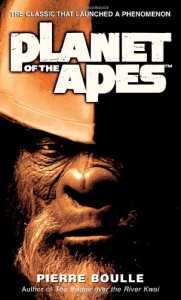
I read Boulle's Planet of the Apes years and years ago, and I remember really enjoying it without knowing quite why--except that it was better (of course) than the movie(s). Last semester, I was designing a class called 'Science Fact and Fiction,' which combines science writing with science fiction, showing where the boundaries are blurred but also how science fiction can often express the same ethical concerns (chiefly through metaphors) that you find in the majority of science writing. I wanted a book that connected somewhat with Skloot's The Immortal Life of Henrietta Lacks and for some reason this book came up. So I assigned it without re-reading it, knowing I would get to it eventually and that, somehow, the connection would make sense.
And it did--just more than I realized. Planet of the Apes is an astounding book which is at once full of ideas and philosophy, but also a cracking good read--I literally could not put the book down, even though I remembered all the plot points. What surprised me most was the frame story which is removed from the film (as are many other prominent features): a vacationing couple is traveling through space in a kind of cosmic sail boat, and they run across a message in a bottle: the message, written in an obscure Earth language (French), contains the entire story. And strangest of all, it claims to be about human beings. The couple is very amused by this, and later we find out why (and you probably have as well).
The gist of the story is the journalist, Ulysse Merou, who travels across space with two companions to discover new worlds and escape the human race. Coincidentally, they find another earth-like planet full of people...who are little more than animals. He is soon captured and caged, made to mate in public and beg for food by his captors, the various groups of apes on planet Soror: the governing gorillas, the official orangutans, and the scientist chimpanzees. Using his knowledge of mathematics, he establishes contact with Zira, one of the head scientists, and convinces her of his humanity--or in this case, 'apeness.' She leads a secret crusade to turn the tables on the tradition-bound orangutans, and prove that man is an intellectual animal like themselves. Once he proves this to the simian world, Ulysee goes on an archaeological expedition with Zira's fiance, Cornelius, to unearth the remains of a 10,000 year-old city once populated by...humans.
Far from being a mere escapist fiction, the book uses the metaphor of apes to explore many issues humanity was facing in the 60's, such as race, scientific progress, the intellectual capability of mankind, and the foundations of education itself. One of the central arguments of the book is how easily we can slide from our intellectual heights to the slime of savagery; mankind is not superior, but must work at it, and is always in danger of falling prey to convention and political agendas. The fate of mankind may seem a bit far-fetched in the book, but again, the work is a metaphor for Boulle's own fears of how easily we abandon the life of the mind for mere comfort--a classic science-fiction theme also explored in Wells' The Time Machine.
But despite all my protestations of its greatness and importance, at the end of the day it's simply a well-written, exciting, living work. You believe in it, though the science is a bit improbable and Ulysse can be a somewhat exasperating narrator. Best of all, it's short and makes its point very succinctly--something a lot of modern-day authors could learn from! I can't recommend it highly enough, and hope some of my students enjoyed it as much as I did (the verdict is still out on that one...)
The Story Coaster from artist Grant Snider
Grant Snider is the enterprising creator of Incidental Comics and also does posters.
Click on the picture to see more of Grant's works:


 2
2
 2
2
